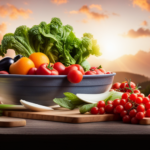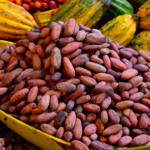In 2008, there was a major global economic crisis that greatly affected the food and raw materials markets. This event was like a fierce storm, causing prices to spike and resulting in widespread economic challenges and uncertainty.
This article delves into the causes behind this tempestuous period and explores the factors that contributed to the unprecedented increase in food and raw material prices. The price surge can be attributed to a complex web of interconnected factors, including supply and demand dynamics, market speculation, energy prices, climate change, government policies, and trade restrictions.
Furthermore, the role of speculators and investors cannot be underestimated in exacerbating the situation. As the storm ravaged economies worldwide, concerns about food security and hunger grew, highlighting the dire consequences of such price volatility.
With an objective lens, this article will analyze the data-driven evidence and delve into the long-term solutions and strategies that can help prevent future storms of this magnitude. By learning from the past, we can navigate the uncertain waters ahead and strive for a more stable, equitable global market.
Key Takeaways
- The increase in food and raw material prices in 2008 was caused by a combination of factors including supply and demand dynamics, market speculation, energy prices, climate change, government policies, and trade restrictions.
- Speculators and investors played a role in exacerbating the situation through excessive speculation in the commodities market, leading to price volatility.
- Factors such as the rising demand for biofuels, trade restrictions, and government subsidies for biofuels contributed to scarcity and higher prices for food and raw materials.
- The impact of energy prices on food and raw material prices was significant, as increased energy costs resulted in higher production costs for these commodities.
The Role of Supply and Demand in the Price Surge
You’ll be amazed at how supply and demand played a major role in the skyrocketing prices of food and raw materials in 2008, leaving families struggling to put food on the table and businesses grappling with soaring production costs. The relationship between supply and demand is fundamental in determining price fluctuations.
In 2008, the imbalance between the availability of food and the increasing demand for it caused prices to surge.
Global trade also had a significant impact on food prices. As countries traded more goods, the demand for raw materials used in production, such as oil and metals, increased. This led to higher costs for businesses, which were then passed on to consumers in the form of higher prices.
Moreover, the rising demand for biofuels, driven by government policies and environmental concerns, further strained the supply of food and raw materials. Agricultural land that was previously used for food production was now diverted to grow crops for biofuel production. This reduced the available land for food crops, leading to scarcity and higher prices.
The interplay between supply and demand, as well as the impact of global trade, were key factors behind the surge in food and raw material prices in 2008. The subsequent section will delve into the role of market speculation and price volatility in exacerbating this situation.
Market Speculation and Price Volatility
Speculative trading plays a significant role in fueling price volatility in markets. By engaging in speculative activities, traders can drive up the price of commodities, such as food and raw materials, through sheer speculation and the anticipation of future price increases.
This can have a detrimental impact on consumers and producers alike, as it distorts the true supply and demand dynamics of the market. Additionally, financial institutions have been known to manipulate prices through various means, such as creating artificial shortages or using complex financial instruments to influence prices in their favor.
These practices further exacerbate price volatility and contribute to the instability of global markets.
Speculative trading and its impact on prices
Amidst the frenzy of trading, the market became a whirlwind of speculation, sending food and raw material prices skyrocketing in 2008. Speculative trading, driven by market speculation, played a significant role in this price surge.
The lack of market regulation allowed for excessive speculation, causing prices to deviate from their fundamental values. As a result, small farmers and producers were particularly impacted. They faced higher input costs, making it more difficult to sustain their operations.
The speculative nature of trading led to increased price volatility and unpredictability, making it challenging for farmers to plan and make informed decisions. This volatility also affected consumers, who had to bear the brunt of rising food prices.
The consequences of speculative trading set the stage for the subsequent section on price manipulation by financial institutions, revealing how the market was further manipulated for profit.
Price manipulation by financial institutions
Get ready to uncover the hidden tactics employed by financial institutions to manipulate prices in their favor. Price manipulation by financial institutions has had a significant impact on the increase in food and raw material prices in 2008.
Here are four alarming ways these institutions have manipulated prices:
-
Artificial scarcity: Financial institutions create an illusion of scarcity by hoarding commodities, driving up their prices artificially.
-
Insider trading: By accessing privileged information, these institutions can make informed trades that manipulate prices to their advantage.
-
Wash trading: Financial institutions engage in wash trading, where they effectively trade with themselves, creating a false impression of market activity and driving prices higher.
-
Market cornering: These institutions monopolize the market by acquiring a significant portion of a particular commodity, giving them the power to control prices.
These manipulative practices by financial institutions have had a devastating impact on the economy.
Transitioning into the subsequent section about the influence of energy prices, we explore another crucial factor that contributed to the increase in food and raw material prices in 2008.
Influence of Energy Prices
The skyrocketing prices of food and raw materials in 2008 were largely driven by the surging energy costs. The impact of renewable energy and the effects of global trade played significant roles in this phenomenon.
As the demand for clean energy sources increased, the production and distribution costs of renewable energy also rose. This resulted in higher energy prices, which had a ripple effect on other sectors of the economy, including agriculture and manufacturing.
Additionally, the effects of global trade cannot be ignored. The interconnectedness of the global economy meant that any disruptions in energy supply or changes in energy prices had far-reaching consequences. Developing countries, in particular, were heavily dependent on imported energy, which made them vulnerable to fluctuations in prices.
As a result, the increased energy costs translated into higher production costs for food and raw materials, ultimately leading to price hikes in these sectors. The influence of energy prices on the overall increase in food and raw material prices in 2008 highlights the interconnected nature of the global economy and the need for a comprehensive understanding of the factors at play.
This understanding is crucial as we delve into the subsequent section about the impact of climate change.
Impact of Climate Change
The influence of energy prices on the increase in food and raw material prices in 2008 was substantial, but it’s important to consider other factors as well.
One such factor is the impact of climate change on agricultural productivity. Climate change has been causing shifts in temperature and rainfall patterns, leading to changes in growing seasons and crop yields. These changes have had a significant effect on food production and availability.
Climate change adaptation is crucial for maintaining and improving agricultural productivity in the face of these challenges. Farmers and agricultural industries need to develop strategies to mitigate the negative effects of climate change and adapt their practices accordingly. This may involve implementing technologies and practices that conserve water, improve soil health, and optimize resource use. Additionally, investing in research and development for climate-resilient crop varieties and farming techniques can help ensure food security in the long term.
By understanding the impact of climate change on agricultural productivity and implementing effective adaptation strategies, we can work towards reducing the vulnerability of food and raw material prices to future climate-related shocks. However, it’s not the only factor at play. Government policies and trade restrictions also play a significant role in shaping food prices and will be discussed in the subsequent section.
Government Policies and Trade Restrictions
Imagine how government policies and trade restrictions can have a powerful impact on the availability and affordability of essential goods like food and raw materials. Governments play a crucial role in shaping the global market through their intervention in trade agreements.
In 2008, these policies contributed to the increase in prices of food and raw materials. One of the key factors was the imposition of export restrictions by several countries. These restrictions limited the amount of goods available for export, causing a decrease in global supply and subsequently driving up prices. Additionally, some governments implemented subsidies for biofuels, diverting agricultural production away from food and towards fuel production. This further reduced the supply of food and raw materials, leading to price hikes.
Government policies also had indirect effects. For instance, trade agreements that favored protectionism led to higher tariffs and barriers to trade. This hindered the flow of goods across borders, limiting access to cheaper alternatives and exacerbating price increases.
The impact of government intervention and trade restrictions on food and raw material prices cannot be underestimated. It’s crucial for policymakers to carefully consider the long-term consequences of such policies.
As we delve into the subsequent section about global economic factors, we will explore how these policies interacted with other key factors to create the perfect storm in 2008.
Global Economic Factors
Picture yourself in a world where the global economy is a complex web of interconnected factors, each one influencing the other, like a delicate balance that can easily tip towards instability.
In 2008, the world experienced a global economic recession that had a profound impact on food and raw material prices. The recession resulted in a decrease in consumer demand and a decline in economic activity, which led to a decrease in the production and consumption of food and raw materials. This decrease in demand, coupled with a decrease in agricultural productivity, created a shortage in the global supply of food and raw materials, causing prices to increase.
During the global economic recession, countries faced financial constraints and reduced access to credit, which affected their ability to invest in agricultural development and improve productivity. Additionally, the recession led to a decrease in investments in research and development, which could have improved agricultural productivity and mitigated the effects of the shortage.
As the global economy recovered from the recession, the role of speculators and investors became increasingly prominent in driving food and raw material prices. These actors, motivated by the potential for profit, began to engage in speculative activities, such as buying and selling futures contracts, which further increased price volatility.
Transitioning into the subsequent section about the role of speculators and investors, it’s crucial to understand the impact of their actions on the global economy.
The Role of Speculators and Investors
In the previous section, we discussed the global economic factors that contributed to the increase in food and raw material prices in 2008. Now, let’s delve into the role of speculators and investors in this phenomenon.
Speculators and investors play a significant role in the commodities market, where food and raw materials are traded. They buy and sell these commodities based on their expectations of future price movements. Their actions can have a profound impact on prices, especially when they are driven by speculation rather than actual supply and demand fundamentals.
One key factor that exacerbated the price increase in 2008 was the lack of regulations in the commodities market. This allowed speculators and investors to engage in excessive speculation, driving prices even higher. Additionally, the financialization of commodity markets attracted more investors seeking to diversify their portfolios, further fueling price volatility.
While these activities may have been profitable for some, they had severe consequences for small farmers and vulnerable populations. The skyrocketing prices made it difficult for small farmers to afford essential inputs like fertilizers and seeds. This, in turn, affected their productivity and ability to feed their families and communities.
As we move forward, it’s crucial to address the implications of this price surge on food security and hunger concerns.
Food Security and Hunger Concerns
Now, let’s explore the impact of this surge in commodity costs on your access to food and the pressing issue of hunger.
The increase in food and raw material prices in 2008 had serious implications for food security and hunger concerns around the world. As prices soared, it became increasingly difficult for individuals and families, particularly those in developing countries, to afford basic food items. This led to a rise in malnutrition rates and an increase in the number of people facing hunger.
Food aid programs played a crucial role in addressing the immediate needs of those affected by the spike in prices. These programs aimed to provide emergency assistance, such as distributing food supplies and offering nutritional support to vulnerable populations. However, the demand for food aid increased significantly, putting strain on existing resources and highlighting the need for long-term solutions.
Agricultural subsidies also came into focus during this period. Some argued that these subsidies, primarily provided by developed countries, distorted global food prices and hindered the ability of farmers in developing nations to compete in the international market. This further exacerbated the challenges faced by vulnerable communities in accessing affordable and nutritious food.
The surge in food and raw material prices in 2008 had a profound impact on food security and hunger worldwide. Food aid programs and agricultural subsidies played a role in mitigating the immediate consequences, but long-term solutions and strategies are necessary to address the underlying issues causing this vulnerability.
Long-Term Solutions and Strategies
Transition: As we explore long-term solutions to address food security and hunger concerns, it is crucial to implement strategies that promote sustainable agriculture and invest in research and development.
Current Subtopic: Long-Term Solutions and Strategies
In order to ensure a stable and secure food supply, it is imperative to adopt strategies that focus on sustainable agriculture. This involves promoting practices that minimize environmental impact, conserve natural resources, and enhance productivity. By implementing techniques such as crop rotation, organic farming, and integrated pest management, we can mitigate the negative effects of climate change, protect biodiversity, and improve soil health.
Additionally, investment in research and development is key to addressing the challenges posed by rising food and raw material prices. By supporting scientific advancements in crop breeding, genetic engineering, and agricultural technology, we can enhance crop yields, develop drought-resistant varieties, and improve overall agricultural productivity. Furthermore, research can help identify innovative methods for food storage and distribution, reducing post-harvest losses and ensuring food reaches those in need.
By combining sustainable agriculture practices with investment in research and development, we can build a resilient food system that can withstand future shocks and ensure food security for all.
Transition: Looking towards the future, it is important to reflect on the lessons learned from the 2008 food and raw material price increase and consider the outlook for global food security.
Lessons Learned and Future Outlook
Ironically, the skyrocketing costs of essential resources opened our eyes to the fragility of our global food system. The 2008 increase in food and raw material prices served as a wake-up call, highlighting the vulnerabilities and interdependencies within our global supply chains. It became evident that factors such as climate change, population growth, and economic instability were all contributing to the challenge of achieving food security.
Looking back, several lessons have been learned from this crisis. Firstly, it’s crucial to diversify food sources and reduce dependency on a limited number of regions for production. This can help mitigate the impact of climate-related events or political disruptions.
Secondly, investing in agricultural research and development is vital to enhance productivity and adaptability in the face of changing environmental conditions.
Thirdly, policymakers need to prioritize strategies that promote sustainable farming practices and ensure equitable access to resources for small-scale farmers.
Lastly, global economic factors, such as currency fluctuations and trade policies, must be carefully monitored to prevent market distortions and price volatility.
Moving forward, it’s crucial to apply these lessons and continue working towards a more resilient and sustainable global food system. By addressing the underlying causes of the 2008 price spike, we can strive to achieve long-term food security while considering the socioeconomic and environmental dimensions of our actions.
Frequently Asked Questions
How did the increase in food and raw material prices in 2008 impact the global economy?
The increase in food and raw material prices in 2008 had a significant impact on the global economy. Developing countries were hit the hardest, as they struggled to afford essential food and resources. This led to increased poverty rates and social unrest in many regions.
Additionally, global food security was compromised, as the rising prices made it difficult for countries to meet the nutritional needs of their populations.
Overall, the economic consequences of this price increase were far-reaching and had lasting effects on both developing and developed nations.
What are the main factors contributing to the rise in food and raw material prices in 2008?
The rise in food and raw material prices in 2008 can be attributed to various factors. Market demand played a significant role, as growing populations and changing dietary preferences increased the need for these resources.
Additionally, supply chain disruptions, such as adverse weather conditions and increased transportation costs, impacted the availability and distribution of these goods.
These factors together contributed to the overall increase in prices during that period.
How did market speculation and price volatility affect the increase in food and raw material prices in 2008?
Market speculation and price volatility had a significant impact on the surge in food and raw material prices in 2008. It was like a domino effect, as the unstable prices and uncertain market conditions fueled further speculation, leading to even more price fluctuations.
This created an environment of uncertainty and unpredictability, making it difficult for producers and consumers to plan and make informed decisions. The excessive speculation and price volatility exacerbated the already existing factors contributing to the rise in prices, ultimately leading to the sharp increase in food and raw material prices in 2008.
What role did government policies and trade restrictions play in the 2008 price surge?
Government policies and trade restrictions played a significant role in the 2008 price surge. Restrictions on exports by major grain-producing countries, such as Russia and Argentina, reduced the global supply of food and raw materials.
Additionally, some governments implemented policies that favored biofuel production, diverting agricultural resources away from food production. These measures, combined with the overall increase in demand, exacerbated the price volatility and contributed to the surge in prices during that period.
What are some long-term solutions and strategies to prevent future increases in food and raw material prices?
One long-term sustainable solution to prevent future increases in food and raw material prices is effective supply chain management. By improving coordination and efficiency in the supply chain, we can reduce waste, minimize disruptions, and ensure a steady flow of goods.
This can be achieved through better infrastructure, technology adoption, and collaboration among stakeholders. Implementing robust monitoring systems and implementing transparent policies can also help identify and address potential issues early on.
By focusing on supply chain management, we can create a more resilient and stable market for food and raw materials.
Did the Increase in Raw Material Prices in 2008 Impact the Cost of Food?
Yes, the increase in raw material prices in 2008 definitely impacted the cost of food. The rising prices of wheat, corn, and other constitutes raw food pushed production costs higher, causing the prices of food products to increase as well. This made it difficult for many people to afford basic food items.
Conclusion
In conclusion, the surge in food and raw material prices in 2008 was like a raging storm that shook the foundations of global markets. Supply and demand imbalances, market speculation, energy price fluctuations, climate change impacts, government policies, and trade restrictions all played a part in fueling this tempest. However, we must not forget the role of speculators and investors who added fuel to the fire.
As we reflect on this tumultuous period, we must seek long-term solutions and strategies to ensure food security and alleviate hunger concerns. Only then can we weather future storms with greater resilience and foresight.

















